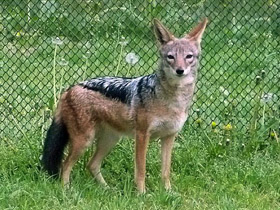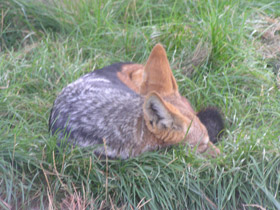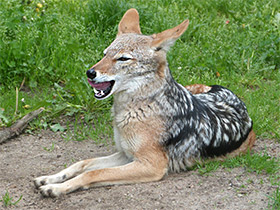The black-backed jackal, the silver-backed jackal (Lupulella mesomelas or Canis mesomelas)
Black-backed jackal видео
The black-backed jackal (Lupulella mesomelas or Canis mesomelas), also called the silver-backed jackal, is a medium-sized canine native to eastern and southern Africa. These regions are separated by roughly 900 kilometers.
One region includes the southernmost tip of the continent, including South Africa, Namibia, Botswana, and Zimbabwe. The other area is along the eastern coastline, including Kenya, Somalia, Djibouti, Eritrea, and Ethiopia. It is listed by the IUCN as least concern, due to its widespread range and adaptability, although it is still persecuted as a livestock predator and rabies vector.
Compared to members of the genus Canis, the black-backed jackal is a very ancient species, and has changed little since the Pleistocene, being the most basal wolf-like canine, alongside the closely related side-striped jackal. It is a fox-like animal with a reddish brown to tan coat and a black saddle that extends from the shoulders to the base of the tail. It is a monogamous animal, whose young may remain with the family to help raise new generations of pups. The black-backed jackal has a wide array of food sources, feeding on small to medium-sized animals, as well as plant matter and human refuse.
Distribution and appearance
Lupulella mesomelas, is a species of carnivorous mammal in the family Canidae.
Canis mesomelas is common in South Africa and along the east coast of Africa from Namibia to the Cape of Good Hope. It is a large animal, with a length of 75-100 cm and a height at the withers of 50 cm and a weight of up to 21 kg. Lupulella mesomelas has a pointed, fox-like snout, large pointed ears and a bushy tail. Lupulella mesomelas differs from the common jackal in having black and silver-grey markings on its back, the so-called "cheprak".
Nutrition
Lupulella mesomelas is undemanding and omnivorous. Flocks of Lupulella mesomelas accompany lions, leopards and hyenas in the hope of scavenging, and readily feed on carrion. Lupulella mesomelas feed on seal pups, young gazelles and antelopes, hares, not forgetting rodents, lizards and snakes, insects, as well as fruits and berries. They sometimes attack cattle, goats and sheep, making them bitter enemies of farmers. Lupulella mesomelas is one of the luckiest hunters, being successful in 75% of Thomson's gazelle hunts. They bury their prey in the ground and eat it the next day.
Social behaviour and reproduction
Lupulella mesomela is monogamous and pairs remain together for 8 years or more. Both partners help each other: they hunt together, mark territory, share food and reproduce. They express their affection for each other with constant licking and barking when hunting in different places. A pair of Lupulella mesomelas protects their territory from strangers. The male and female mark the boundaries of their territory with urine. The scent marks on their glands, with which Lupulella mesomelas mark their territory, contain information about the sex, health, sexual potency and age of the host.
Their family group is small, consisting of a breeding pair and several older pups that then help their parents raise the next generation. Flocks with "helpers" have higher survival rates than flocks without. Like the parents, the "helper" burps food for the young, protects them from predators and hunts with the family, assisting in the hunt. As they grow up, the cubs play a lot, establishing a strict hierarchy system within their cub pack. As they grow older, this type of play becomes more and more aggressive. Among the congeners of Lupulella mesomelas, they are most prone to games that mimic future social relationships in the pack. The end result of these games is the choice of who will stay with their parents on the property and who will leave the pack. Dominant puppies, who win more fights for food and have an independent character, leave the pack. When conditions are unfavourable for independent living, on the contrary, they stay with their parents and outlive their weaker siblings in the herd.
Pregnancy in Lupulella mesomelas lasts about 60 days. The female gives birth to 3 to 6 young, which are usually born during the dry season (July to October). Lupulella mesomelas makes its den in termite mounds or in old anteater burrows. The male feeds the pregnant female and, for the first three weeks after the birth of the young, is almost inseparable from them. Five times a day the female feeds the cubs with milk. At 10 days of age, the cubs' eyes open, and at two weeks of age they emerge from the den and begin to explore the surrounding area. For a month, the cubs feed on the food provided by their parents, who have returned from hunting. The female often changes her den to deceive predators. At three months of age, young Lupulella mesomelas stop receiving milk and hunt with their parents. At 6 months of age, they hunt on their own and, at 6-8 months, the young leave the parents' area to settle in their own territory.
Subspecies
Canis mesomelas mesomelas in Chobe National Park, Botswana.
The following subspecies are known:
- Lupulella mesomelas mesomelas, South African black-backed jackal. - See Physical description below. Cape of Good Hope northward to Angola, Namibia, Zimbabwe, and southern Mozambique.
- Lupulella mesomelas schmidti, East African black-backed jackal. - Distinguished from the nominate subspecies by its shorter and wider skull, longer and narrower carnassials, and smaller upper and lower molar grinding areas. Southern Ethiopia, South Sudan, Somalia, Kenya, Uganda, and northern Tanzania.
Diseases and parasites
Black-backed jackals can carry diseases such as rabies, canine parvovirus, canine distemper, canine adenovirus, Ehrlichia canis, and African horse sickness. Jackals in Etosha National Park may carry anthrax. Black-backed jackals are major rabies vectors, and have been associated with epidemics, which appear to cycle every 4–8 years. Jackals in Zimbabwe are able to maintain rabies independently of other species. Although oral vaccinations are effective in jackals, the long-term control of rabies continues to be a problem in areas where stray dogs are not given the same immunisation.
Jackals may also carry trematodes such as Athesmia, cestodes such as Dipylidium caninum, Echinococcus granulosus, Joyeuxialla echinorhyncoides, Joyeuxialla pasqualei, Mesocestoides lineatus, Taenia erythraea, Taenia hydatigena, Taenia jackhalsi, Taenia multiceps, Taenia pungutchui, and T. serialis. Nematodes carried by black-backed jackals include Ancylostoma braziliense, Ancylostoma caninum, Ancylostoma martinaglia, Ancylostoma somaliense, A. tubaeforme, and Physaloptera praeputialis, and protozoans such as Babesia canis, Ehrlichia canis, Hepatozoon canis, Rickettsia canis, Sarcocytis spp., Toxoplasma gondii, and Trypanosoma congolense. Mites may cause sarcoptic mange. Tick species include Amblyomma hebraeum, Amblyomma marmoreum, Amblyomma nymphs, Amblyomma variegatum, Boophilus decoloratus, Haemaphysalis leachii, Haemaphysalis silacea, Haemaphysalis spinulosa, Hyelomma spp, Ixodes pilosus, Ixodes rubicundus, Rhipicephalus appendiculatus, Rhipicephalus evertsi, Rhipicephalus sanguineus, and Rhipicephalus simus. Flea species include Ctenocephalides cornatus, Echidnophaga gallinacea, and Synosternus caffer.


















































